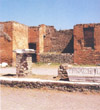
RELIGIOUS BELIEFS
It is a recurring feature of human history and Pompeii was no exception that man's religious practices have been a mixture of both public and private devotion and superstition, and have often reached ridiculous levels of symbolism in order to ward off bad luck or the evil eye. The ancient cults of the local inhabitants, which were generally linked to the rituals of nature and fertility, later gave way to the worship of Hercules, Bacchus and Venus, the chosen patrons of Pompeii. In Pompeii, Venus was worshipped as the creator of the universe since it was she who meted out life and death;
she was the Venus of Pompeii (Venus Pompeiana) and also mother nature (Venus Physica) and the goddess of fertility an abundance.
A temple was created in honour of the goddess on the promontory which could be seen from the sea, and many images of her were displayed around the town. Other popular cults included that of Apollo (the main god worshipped in Pompeii in the VI century B.C.) and the cult of the Capitoline triad of Jupiter, Juno and Minerva, whose temple, or Capitolium, stood to the north of the Forum, The Pompeians also honoured the divinities who watched over the goods which were transported by sea and along the river Sarno. Outside Pompeii, near the town's river port, a sanctuary was erected to Neptune and a votive shrine was found there along with an inscription.
Of course, the cult of the Emperor also widespread, and in particular his Genius and his Fortune were revered. A private citizen erected the Temple of Fortuna Augusta at his own expense near the Forum, while a temple was built and dedicated to the Genius of Vespasian in small area of the Forum itself. Nearby, a Temple to the Public Lares was built, probably after the earthquake of 62 A.D. It was dedicated to the protectors of the town in order to regain their goodwill and placate their anger as, according to popular belief, this had been responsible for the terrible calamity.
Frequent contact with the East led to the importation of rites involving orgies which were dedicated in particular to Isis. A temple was erected to the Egyptian goddess in the theatre district and several houses in Pompeii bear witness to her cult. In the so called House of Magical Rites, dedicated to the god Sabatius, some interesting finds include two bronze magic hands and two sacrificial vases. Lastly, evidence of the cult of the Magna Mater, the great goddess Cybele or the Great mother of the Gods who was associated with fertility and fecundity, can be seen in popular paintings such as those in a felt-makers’ shop in Via dell’Abbondanza. Oriental cults enjoyed a considerable following since they professed theories of salvation by promising a better after-life.
In any house the religious nature of the inhabitants of Pompeii was clearly visible in the cult of the Lares, to whom an altar was also dedicated.
The tutelary deities of the house were originally the spirits of the ancestors who in various paintings were often accompanied by the Geniuses, i.e. the symbols of the procreating strength of the head of each family. The most popular simulacra of the town's divinities can be seen in some of the paintings discovered here, but they were more often represented in bronzes placed on altar shelves. Libations were frequently offered to them during meals in order to obtain their favour. The roots of Pompeian religious beliefs basically lay in superstition. Practices against the evil eye and every kind of disease in favour of health, fertility and love were very common, as is indicated by the various amulets discovered around the town. The most popular amulet among the Pompeians was the phallus. It was reproduced in every possible manner, from paintings and bas-reliefs to pendants, and could be found everywhere: on the walls of houses, at the entrances to shops, on fountains and even inside houses.






